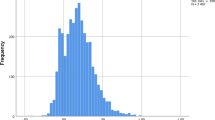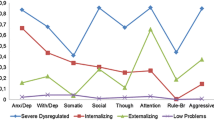Abstract
The aim of this study was to elucidate the nature of comorbidity between internalising and externalising syndromes and its meaning in the course of these syndromes from 8 to 12 years of age in a school setting. The children in the cohort (N=1320) were born in 1981. They were first surveyed in second grade (N=1284) and followed up in sixth grade (N=906). Teachers were the informants, and the study was carried out by means of a questionnaire. Data from both points of time were available on 861 subjects. The Rutter Teacher Questionnaire (RB2) measured behavioural and emotional symptoms at Time 1, and the Teacher Report Form (TRF) at Time 2. Comorbidity was more prevalent in boys than girls. Childhood comorbidity predicted externalising syndrome and comorbidity, but not internalising syndrome in early adolescence. It changed the course of boys’ internalising syndromes to an externalising direction over time. The data suggest a gender difference in the pattern of comorbidity. When comorbidity was partialled out, it was very rare for internalising and externalising syndromes to develop into contrasting syndromes over time. The recovery rate for childhood comorbidity was poor. Special attention should be paid to making schools recognise and help these children.
Similar content being viewed by others
References
Achenbach TM (1991) Manual for the Teacher’s Report Form and 1991 profile. Burlington, VT: University of Vermont Department of Psychiatry
Anderson JC, Williams S, McGee R, Silva PA (1987) DSM-III disorders in preadolescent children. Prevalence in a large sample from the general population. Archives of General Psychiatry 44:69–76
Caron C, Rutter M (1991) Comorbidity in child psychopathology: concepts, issues and research strategies. Journal of Child Psychology and Psychiatry 32:1063–1080
Chiles JA, Miller ML, Cox GB (1980) Depression in an adolescent delinquent population. Archives of General Psychiatry 37:1179–1184
Cohen P, Cohen J, Kasen S, Velez CN, Hartmark C, Johnson J, Rojas M, Brook J, Streuning EL (1993) An epidemiological study of disorders in late childhood and adolescence — I. Age- and gender-specific prevalence. Journal of Child Psychology and Psychiatry 34:851–867
Cole DA, Carpentieri S (1990) Social status and the comorbidity of child depression and conduct disorder. Journal of Consulting and Clinical Psychology 58:748–757
Elander J, Rutter M (1996) Use and development of the Rutter Parents’ and Teachers’ Scales. International Journal of Methods in Psychiatric Research 6:63–78
Esser G, Schmidt MH, Woerner W (1990) Epidemiology and course of psychiatric disorders in school-age children — results of a longitudinal study. Journal of Child Psychology and Psychiatry 31:243–263
Ferdinand RF, Verhulst FC, Wiznitzer M (1995) Continuity and change of self-reported problem behaviors from adolescence into young adulthood. Journal of the American Academy of Child and Adolescent Psychiatry 34:680–690
Fombonne E (1989) The Child Behavior Checklist and the Rutter Parental Questionnaire: a comparison between two screening instruments. Psychological Medicine 19:777–785
Fombonne E (1991) The use of questionnaires in child psychiatry research: Measuring their performance and choosing an optimal cutoff. Journal of Child Psychology and Psychiatry 32:677–693
Ghodsian M, Fogelman K, Lambert L, Tibbenham A (1980) Changes in behaviour ratings of a national sample of children. British Journal of Social and Clinical Psychology 19:247–256
Harrington R, Fudge H, Rutter M, Pickles A, Hill J (1991) Adult outcomes of childhood and adolescent depression: II. Links with antisocial disorders. Journal of the American Academy of Child and Adolescent Psychiatry 30:434–439
Kasen S, Johnson J, Cohen P (1990) The impact of school emotional climate on student psychopathology. Journal of Abnormal Child Psychology 18:165–177
Kashani JH, Beck NC, Hoeper EW, Fallahi C, Corcoran CM, McAllister JA, Rosenberg TK, Reid JC (1987) Psychiatric disorders in a community sample of adolescents. American Journal of Psychiatry 144:584–589
Kovacs M, Paulauskas S, Gatsonis C, Richards C (1988) Depressive disorders in childhood. III. A longitudinal study of comorbidity with and risk for conduct disorders. Journal of Affective Disorders 15:205–217
Krueger RF, Caspi A, Moffit TE, Silva PA, McGee R (1996) Personality traits are differentially linked to mental disorders: a multitrait — multidiagnosis study of an adolescent birth cohort. Journal of Abnormal Psychology 105:299–312
Marriage K, Fine S, Moretti M, Haley G (1986) Relationship between depression and conduct disorder in children and adolescents. Journal of the American Academy of Child Psychiatry 25:687–691
McConaughy SH, Achenbach TM (1994) Comorbidity of empirically based syndromes in matched general population and clinical samples. Journal of Child Psychology and Psychiatry 35:1141–1157
McConaughy SH, Skiba RJ (1993) Comorbidity of externalising and internalising problems. School Psychology Review 22:421–436
McConaughy SH, Stanger C, Achenbach TM (1992) Three-year course of behavioral/emotional problems in a national sample of 4-to 16-year-olds: I. Agreement among informants. Journal of the American Academy of Child and Adolescent Psychiatry 5:932–940
McGee R, Feehan M, Williams S, Anderson J (1992) DSM-III disorders from age 11 to age 15 years. Journal of the American Academy of Child and Adolescent Psychiatry 31:50–59
McGee R, Feehan M, Williams S, Partridge F, Silva PA, Kelly J (1990) DSM-III disorders in a large sample of adolescents. Journal of the American Academy of Child and Adolescent Psychiatry 29:611–619
Newman DL, Moffitt TE, Caspi A, Magdol L, Silva PA, Stanton WR (1996) Psychiatric disorder in a birth cohort of young adults: prevalence, comorbidity, clinical significance, and new case incidence from ages 11 to 21. Journal of Consulting and Clinical Psychology 64:552–562
Offord DR, Boyle MH, Racine Y (1989) Ontario child health study: correlates of disorder. Journal of the American Academy of Child and Adolescent Psychiatry 28:856–860
Offord DR, Boyle MH, Racine YA, Fleming JE, Cadman DT, Munroe Blum H, Byrne C, Links PS, Lipman FL, McMillan HL, Rae Grant NI, Sanford MN, Szatmari P, Thomas H, Woodward CA (1992) Outcome, prognosis and risk in a longitudinal follow-up study. Journal of the American Academy of Child and Adolescent Psychiatry 31:916–923
Orvaschel H, Lewinsohn PM, Seeley JR (1995) Continuity of psychopathology in a community sample of adolescents. Journal of the American Academy of Child and Adolescent Psychiatry 34:1525–1535
Ouston J, Maughan B, Mortimore P (1980) School influences. In: Rutter M (Ed) Scientific Foundations of Developmental Psychiatry. (Pp. 67–76). London: Medical Books Limited
Puig-Antich J (1982) Major depression and conduct disorders in prepuberty. Journal of the American Academy of Child Psychiatry 21:118–128
Rohde P, Lewihnsohn PM, Seeley JR (1991) Comorbidity of unipolar depression: II. Comorbidity with other mental disorders in adolescents and adults. Journal of Abnormal Psychology 100:214–222
Rubin KH, Xinyin C, McDougall P, Bowker A, Mckinnon J (1995) The Waterloo Longitudinal Project: Predicting internalising and externalising problems in adolescence. Development and Psychopathology 7:751–764
Rutter M (1967) A children’s behaviour questionnaire for completion by teachers: preliminary findings. Journal of Child Psychology and Psychiatry 8:1–11
Rutter M (1970) Isle of Wight revisited: Twenty–five years of child psychiatric epidemiology. Journal of the American Academy of Child and Adolescent Psychiatry 28:633–653
Rutter M (1997) Comorbidity: concepts, claims and choices. Criminal Behaviour and Mental Health 7:265–285
Rutter M, Graham P, Chadwick OFD, Yule W (1976) Adolescent turmoil: fact or fiction? Journal of Child Psychology and Psychiatry 17:35–56
Rutter M, Maughan B, Mortimore P (1979) Fifteen Thousand Hours. London: Open Books
Sclare I (1997) Child Psychology Portfolio. London: Nfer-Nelson
S-PLUS 4 Guide to Statistics (1997) Seattle: Data Analysis Products Division, MathSoft
Stanger C, McConaughy SH, Achenbach TM (1992) Three-year course of behavioral/emotional problems in a national sample of 4-to 16-year-olds: II. Predictors of syndromes. Journal of the American Academy of Child and Adolescent Psychiatry 31:941–950
Verhulst FC, Akkerhuis GW (1989) Agreement between parents’ and teachers’ ratings of behavioral/emotional problems of children aged 4–12. Journal of Child Psychology and Psychiatry 30:123–136
Verhulst FC, Althaus M (1988) Persistence and change in behavioral/emotional problems reported by parents of children aged 4–14: an epidemiological study. Acta Psychiatrica Scandinavica 77:suppl. 339
Verhulst FC, Eussen ML, Berden GF, Sanders-Woudstra J, van der Ende J (1993) Pathways of problem behaviors from childhood to adolescence. Journal of the American Academy of Child and Adolescent Psychiatry 31:924–931
Verhulst FC, Koot HM, Berden GF (1990) Four-year follow-up of an epidemiological sample. Journal of the American Academy of Child and Adolescent Psychiatry 29:440–448
Verhulst FC, van der Ende J (1991) Four-year follow-up of teacher-reported problem behaviours. Psychological Medicine 21:965–977
Verhulst FC, van der Ende J (1991) Assessment of child psychopathology: relationships between different methods, different informants and clinical judgement of severity. Acta Psychiatrica Scandinavica 84:155–159
Verhulst FC, van der Ende J (1992) Six-year developmental course of internalising and externalising problem behaviors. Journal of the American Academy of Child and Adolescent Psychiatry 31:924–931
Verhulst J, van der Ende J (1992) Six-year stability of parent-reported problem behavior in an epidemiological sample. Journal of Abnormal Child Psychology 20:595–611
Verhulst FC, van der Ende J (1993) “Comorbidity” in an epidemiological sample: a longitudinal perspective. Journal of Child Psychology and Psychiatry 34:767–783
Verhulst FC, van Wattum PJ (1993) Two-year stability of self-reported problems in an epidemiological sample of adolescents. Acta Psychiatrica Scandinavica 87:322–328
Woolston JL, Rosenthal SL, Riddle MA, Sparrow SS, Cicchetti D, Zimmerman LD (1989) Childhood comorbidity of anxiety/affective disorders and behavior disorders. Journal of the American Academy of Child and Adolescent Psychiatry 28:707–713
Zoccolillo M (1992) Co-occurrence of conduct disorder and its adult outcomes with depressive and anxiety disorders: A review. Journal of the American Academy of Child and Adolescent Psychiatry 31:547–556
Author information
Authors and Affiliations
Rights and permissions
About this article
Cite this article
Somersalo, H., Solantaus, T. & Almqvist, F. Four-year course of teacher-reported internalising, externalising and comorbid syndromes in preadolescent children. European Child & Adolescent Psychiatry 8 (Suppl 4), S89–S97 (1999). https://doi.org/10.1007/PL00010706
Issue Date:
DOI: https://doi.org/10.1007/PL00010706




